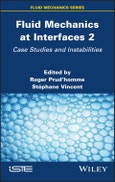Chapter 1 addresses certain aspects of turbulence in discrete mechanics, briefly describing the physical model associated with discrete primal and dual geometric topologies before focusing on channel flow simulations at turbulence-inducing Reynolds numbers. Chapter 2 centers on atomization in an accelerating domain. In one case, an initial Kelvin-Helmholtz instability generates an acceleration field, in turn creating a Rayleigh-Taylor instability which ultimately determines the size of the droplets formed. Chapter 3 explores numerical studies of pipes with sudden contraction using OpenFOAM, and focuses on modeling that will be useful for engines and automobiles.
Chapters 4 and 5 study the evaporation of droplets that are subject to high-frequency perturbations, a possible cause of instabilities in injection engines. The Heidmann model, which replaces the droplets in motion in a combustion chamber with a single continuously-fed droplet, is made more complex by considering the finite conduction heat transfer phenomenon. Finally, Chapter 6 is devoted to a study of the rotor blade surface of a Savonius wind turbine, considering both a non-stationary and a three-dimensional flow.
Table of Contents
Preface ix
Roger PRUD’HOMME, Stéphane VINCENT, Christian CHAUVEAU and Mahouton Norbert HOUNKONNOU
Chapter 1. Turbulent Channel Flow to Reτ = 590 in Discrete Mechanics 1
Jean-Paul CALTAGIRONE and Stéphane VINCENT
1.1. Introduction 1
1.2. Discrete mechanics formulation 4
1.3. Turbulent flow in channel 6
1.3.1. Analysis of a turbulent flow in a planar channel 6
1.3.2. Model of the turbulence in discrete mechanics 12
1.3.3. Application to a turbulent flow in a channel with Reτ =_590 13
1.4. Conclusion 24
1.5. References 24
Chapter 2. Atomization in an Acceleration Field 27
Roger PRUD’HOMME
2.1. Introduction 29
2.1.1. Two classic instabilities 29
2.1.2. Atomization 31
2.2. Generation of droplets through vibrations normal to the liquid layer 32
2.3. Rayleigh-Taylor instability at the crest of an axial wave 36
2.3.1. Size distribution of the drops 39
2.4. Recent work 40
2.5. Conclusion 40
2.6. References 41
Chapter 3. Numerical Simulation of Pipes with an Abrupt Contraction Using OpenFOAM 45
Tarik CHAKKOUR
3.1. Introduction 45
3.2. Modeling an abrupt contraction in a pipe 46
3.2.1. Euler equations 46
3.2.2. Stability of the solver 48
3.2.3. Introducing the model 49
3.2.4. Boundary and initial conditions 51
3.3. Numerical results 54
3.3.1. Results with the boundary and initial conditions I 55
3.3.2. Results with the boundary and initial conditions II 67
3.4. Conclusion and future prospects 73
3.5. References 74
Chapter 4. Vaporization of an Equivalent Pastille 77
Roger PRUD’HOMME and Kwassi ANANI
4.1. Introduction 78
4.2. Equations for the problem 81
4.3. Linear analysis of the liquid phase 82
4.3.1. The function G(u, PeL) 82
4.3.2. Solution 83
4.3.3. The depth to which heat penetrates 84
4.4. Some results 85
4.4.1. Thermal perturbations 85
4.4.2. Response factor 87
4.5. Conclusion 91
4.6. References 92
Chapter 5. Thermal Field of a Continuously-Fed Drop Subjected to HF Perturbations 95
Roger PRUD’HOMME, Kwassi ANANI and Mahouton Norbert HOUNKONNOU
5.1. Drops in a liquid-propellant rocket engine 96
5.2. A continuously fed droplet 98
5.3. Equations of the problem 99
5.3.1. Equations for the gaseous phase 99
5.3.2. Equations for the liquid phase 101
5.4. Linearized equations 102
5.5. Linearized equations for small harmonic perturbations 103
5.6. Thermal field in the drop when neglecting internal convection 103
5.7. Conclusion 107
5.8. Appendix 1: Coefficients that come into play in linearized equations 107
5.9. Appendix 2: Solving the thermal equation 108
5.10. Appendix 3: The case of the equivalent pastille 109
5.11. Appendix 4: 2D representation for the spherical drop 111
5.12. References 113
Chapter 6. Study of the Three-Dimensional and Non-Stationary Flow in a Rotor of the Savonius Wind Turbine 115
Francis RAVELOSON, Delphin TOMBORAVO and Roger VONY
6.1. Introduction 115
6.2. Mathematical modeling of the problem 116
6.2.1. Presentation of a physical model 116
6.2.2. Simplifying hypotheses 119
6.3. Numerical resolution 120
6.3.1. Presentation of meshes 120
6.3.2. Spatial discretization 123
6.3.3. Temporal discretization 123
6.3.4. Stability condition for the scheme 124
6.3.5. Initial conditions 125
6.3.6. Boundary conditions 125
6.4. Validation of the results 126
6.5. Results and discussion 127
6.5.1. Influence of the advance parameter 127
6.5.2. Influence of the angular position of the blades 134
6.6. Conclusion 144
6.7. Acknowledgments 144
6.8. References 144
List of Authors 147
Index 149
Summary of Volume 1 151








